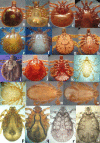Ixodid Tick Vectors of Wild Mammals and Reptiles of Southern India
- PMID: 30584551
- PMCID: PMC6297722
Ixodid Tick Vectors of Wild Mammals and Reptiles of Southern India
Abstract
Background: We aimed to focus on the ixodid ticks parasitizing wild mammals and reptiles from Wayanad Wildlife Sanctuary, Western Ghat, southern India.
Methods: The taxonomic identification of ticks collected from wild mammals and reptiles was performed based on the morphology of adults.
Results: We revealed eight species of ticks including, Amblyomma integrum, Rhipicephalus (Boophilus) annulatus, Haemaphysalis (Kaiseriana) spinigera, H. (K.) shimoga, H. (K.) bispinosa, H. (Rhipistoma) indica, Rhipicephalus haemaphysaloides and R. sanguineus s.l. collected from nine species of wild mammals while four tick species Ablyomma kraneveldi, A. pattoni, A. gervaisi and A. javanense parasitizing on four species of reptiles. The highest host richness was shown by H. (K.) bispinosa and R. haemaphysaloides parasitizing six and five different host species, respectively. Reports of R. (B.) annulatus on sambar deer, A. javanense and A. kraneveldi on python as well as A. pattoni on Indian rat snake are the new host records from this region.
Conclusion: Eight species of ticks parasitizing on nine species of wild mammals and four species of parasitizing on four species of reptiles were identified. The highest host richness was shown by H. (K.) bispinosa and R. haemaphysaloides. H. spinigera as the vector of KFD was also identified in this study.
Keywords: Reptiles; South India; Ticks; Wayanad; Wild mammals.
Figures

Similar articles
-
Ticks and accompanying pathogens of domestic and wild animals of Kerala, South India.Exp Appl Acarol. 2019 Sep;79(1):137-155. doi: 10.1007/s10493-019-00414-z. Epub 2019 Sep 5. Exp Appl Acarol. 2019. PMID: 31489558
-
Ixodid ticks parasitizing Iberian red deer (Cervus elaphus hispanicus) and European wild boar (Sus scrofa) from Spain: geographical and temporal distribution.Vet Parasitol. 2006 Aug 31;140(1-2):133-42. doi: 10.1016/j.vetpar.2006.03.033. Epub 2006 May 3. Vet Parasitol. 2006. PMID: 16675125
-
The species distribution of ticks & the prevalence of Kyasanur forest disease virus in questing nymphal ticks from Western Ghats of Kerala, South India.Indian J Med Res. 2021 May;154(5):743-749. doi: 10.4103/ijmr.IJMR_234_19. Indian J Med Res. 2021. PMID: 35532592 Free PMC article.
-
[The characteristics of tick species (Acari: Ixodida) transferred on exotic reptiles to Poland].Wiad Parazytol. 2010;56(1):29-42. Wiad Parazytol. 2010. PMID: 20450006 Review. Polish.
-
A list of the 70 species of Australian ticks; diagnostic guides to and species accounts of Ixodes holocyclus (paralysis tick), Ixodes cornuatus (southern paralysis tick) and Rhipicephalus australis (Australian cattle tick); and consideration of the place of Australia in the evolution of ticks with comments on four controversial ideas.Int J Parasitol. 2014 Oct 15;44(12):941-53. doi: 10.1016/j.ijpara.2014.08.008. Epub 2014 Sep 16. Int J Parasitol. 2014. PMID: 25236960 Review.
Cited by
-
Ticks and accompanying pathogens of domestic and wild animals of Kerala, South India.Exp Appl Acarol. 2019 Sep;79(1):137-155. doi: 10.1007/s10493-019-00414-z. Epub 2019 Sep 5. Exp Appl Acarol. 2019. PMID: 31489558
-
Modulation of the PGE2-Mediated Pathway in the Eclosion Blocking Effect of Flumethrin and Terpenoid Subfraction Isolated from Artemesia nilagirica in Rhipicephalus annulatus.Molecules. 2021 Aug 13;26(16):4905. doi: 10.3390/molecules26164905. Molecules. 2021. PMID: 34443500 Free PMC article.
-
Tick-, flea- and mite-borne pathogens and associated diseases of public health importance in Bangladesh: a review.Infect Med (Beijing). 2024 Oct 19;3(4):100146. doi: 10.1016/j.imj.2024.100146. eCollection 2024 Dec. Infect Med (Beijing). 2024. PMID: 39687692 Free PMC article. Review.
-
Prevalence and Abundance of Ixodid Ticks in Domestic Mammals in Villages at the Forest Fringes of the Western Ghats, India.Animals (Basel). 2025 Jul 8;15(14):2005. doi: 10.3390/ani15142005. Animals (Basel). 2025. PMID: 40723468 Free PMC article.
-
Transcriptome Profiling of Rhipicephalus annulatus Reveals Differential Gene Expression of Metabolic Detoxifying Enzymes in Response to Acaricide Treatment.Biomedicines. 2023 May 6;11(5):1369. doi: 10.3390/biomedicines11051369. Biomedicines. 2023. PMID: 37239047 Free PMC article.
References
-
- Sonenshine DE. (1991) Biology of Ticks. Volume 1 Oxford University Press, New York.
-
- Walker DH, Fishbein DB. (1991) Epidemiology of rickettsial diseases. Eur J Epidemiol. 7(3): 237–245. - PubMed
-
- Snelson JT. (1975) Animal ectoparasites and disease vector causing major reduction in world food supplies. FAO Plant Protection Bulletin. 13: 103–114.
-
- Guglielmone AA, Robbins RG, Apanaskevich DA, Petney TN, Estrada-Peña A, Shao R, Barker SC. (2010) The Argasidae, Ixodidae and Nuttalliellidae (Acari: Ixodida) of the world: a list of valid species names. Zootaxa. 2528: 1–28.
-
- Nava S, Venzal JM, Terassini FA, Mangold AJ, Camargo LM, Labruna MB. (2010) Description of a new argasid tick (Acari: Ixodida) from bat caves in Brazilian Amazon. J Parasitol. 96(6): 1089–1101. - PubMed
LinkOut - more resources
Full Text Sources
